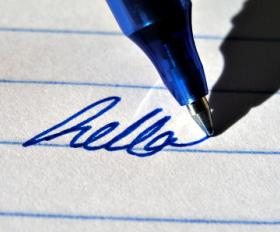© 2006 All Rights Reserved. Do not distribute or repurpose this work without written permission from the copyright holder(s).
Printed from https://danginteresting.com/does-your-handwriting-express-your-personality/

It is a technique used all over the world, and training in it is widely offered. Many employers, especially in France, rely on it heavily to evaluate contenders for high positions. Specialists are called upon to share their views in court and even for the Secret Service. Which technique is this? Graphology, or the analysis of handwriting to reveal character traits.
Along with the International Graphology Association itself, handwriting experts generally object to being associated with anything New Age. Yet psychologists tend to agree that graphology is a pseudoscience. The fact is that the empirical evidence overwhelmingly refutes it; of all the studies which have examined graphology, only one has found a correlation between personality and handwriting styles. The British Psychological Association considers handwriting analysis to be absolutely worthless. The consensus from the psychology world is that graphology is only slightly more useful than astrology. Yet the practice continues.
The “slightly” comes in because, as it turns out, it is possible to correctly predict a writer’s gender more often than chance could account for. There are also clues that indicate hand preference and certain neurological disorders, but psychology has found nothing else to be reliably determinable from handwriting. How, then, has graphology won over so many? What about it is so persuasive-especially when a lot of its devotees are critical of astrology and the like?
Arguable difficulties with astrology are that a) you had no control over your zodiac sign, and b) you share it-and your horoscopes-with more or less 1/12 of the world’s population. Neither of these issues seem to affect handwriting, however. First of all, your writing style is unique, just as is your personality. Second, you have total control over how you write.
However, these factors doesn’t lead to a necessary connection with personality. As mentioned, the differences in people’s handwriting styles come mainly from specific physiology-something else no two people have in common. Not to mention that it depends, to some extent, on how you learned to write. The “in-control” argument can also be taken in the opposite direction: handwriting is not difficult to change. Hey, want to be competitive? Then start using sharp angles to connect upwards to letters, such as between w and h. Athletic? Emphasize and enlarge everything below the base line, including the bottoms of y, g, and j. More social? Make sure your letters slant to the right!

This is clearly problematic. If personality determines handwriting, there is no way to account for the fact that a normal distribution of personalities in early 20th-century American children all ended up with relatively similar handwriting through the Palmer Method. Conversely, more recently there have been courses offered in handwriting improvement. It’s silly to think that its students generally emerge with brand new character traits. And, finally, what to say about calligraphers, or others who specialize in many forms of lettering?
These are only the logical reasons, though. Some of the appeal of graphology lies in its emotional effects. Social psychology tells us that handwriting analysis relies in part on the “representativeness heuristic”, meaning that similar concepts can intuitively feel connected. “Like goes with like.” It makes sense, for example, that someone writing in sharp angles instinctively seems fierce, confident and even cutthroat. Naturally someone writing with a leftward slant is seen as going “against” the proper course of left-to-right script, thus subtly appearing reluctant and perhaps even withdrawn. As for someone crossing a double T with a single line supposedly being efficient…well, that’s obvious.
And then there’s the Forer effect, which also befalls astrology. Based on experiments done in the 1940s by psychologist Bertram R. Forer, it holds that people tend to accept generic personality descriptions as not only highly accurate, but created specifically for them individually. The effect is related to “confirmation bias”, the tendency for people to pay attention only to evidence that supports their pre-existing beliefs.
Alongside increased awareness of these and other factors, graphology’s credibility took a hit last year through a single incident at the annual World Economic Forum held in Switzerland. There, reporters presented to several graphologists a sample they claimed was of British Prime Minister Tony Blair’s handwriting, and asked for expert opinions. After examining the document, one such expert claimed that “Mr. Blair’s” handwriting displayed a “death wish”. Another described a perceived “inability to complete tasks” hidden among the letters. This prompted a small but noticeable worry among the British; some began to believe that Blair might not have been worthy of the job.
Only after these views were publicized was it revealed that the handwriting had come not from the politician, but from…Bill Gates. Bill Gates-worth over $50 billion-a man with a death wish? Unable to complete tasks? It sounded absolutely ludicrous. Needless to say, the press quite enjoyed it-and ensured that a lot of readers found out.
Another handwriting expert later protested, claiming that the analysis was taken out of context and meant nothing when not coupled with other forms of personality testing. But his colleagues’ conviction had been quite apparent.
Indeed, it all points towards graphology being a rather misguided-if earnest-attempt at nailing down the mystery of personality and the mind. From a distance, it doesn’t sound as baseless as it is. But if the lack of objective evidence epitomized in the Blair/Gates switch is any indication, then your handwriting is most certainly not a means of unwittingly giving away your innermost thoughts and attributes.
© 2006 All Rights Reserved. Do not distribute or repurpose this work without written permission from the copyright holder(s).
Printed from https://danginteresting.com/does-your-handwriting-express-your-personality/
Since you enjoyed our work enough to print it out, and read it clear to the end, would you consider donating a few dollars at https://danginteresting.com/donate ?